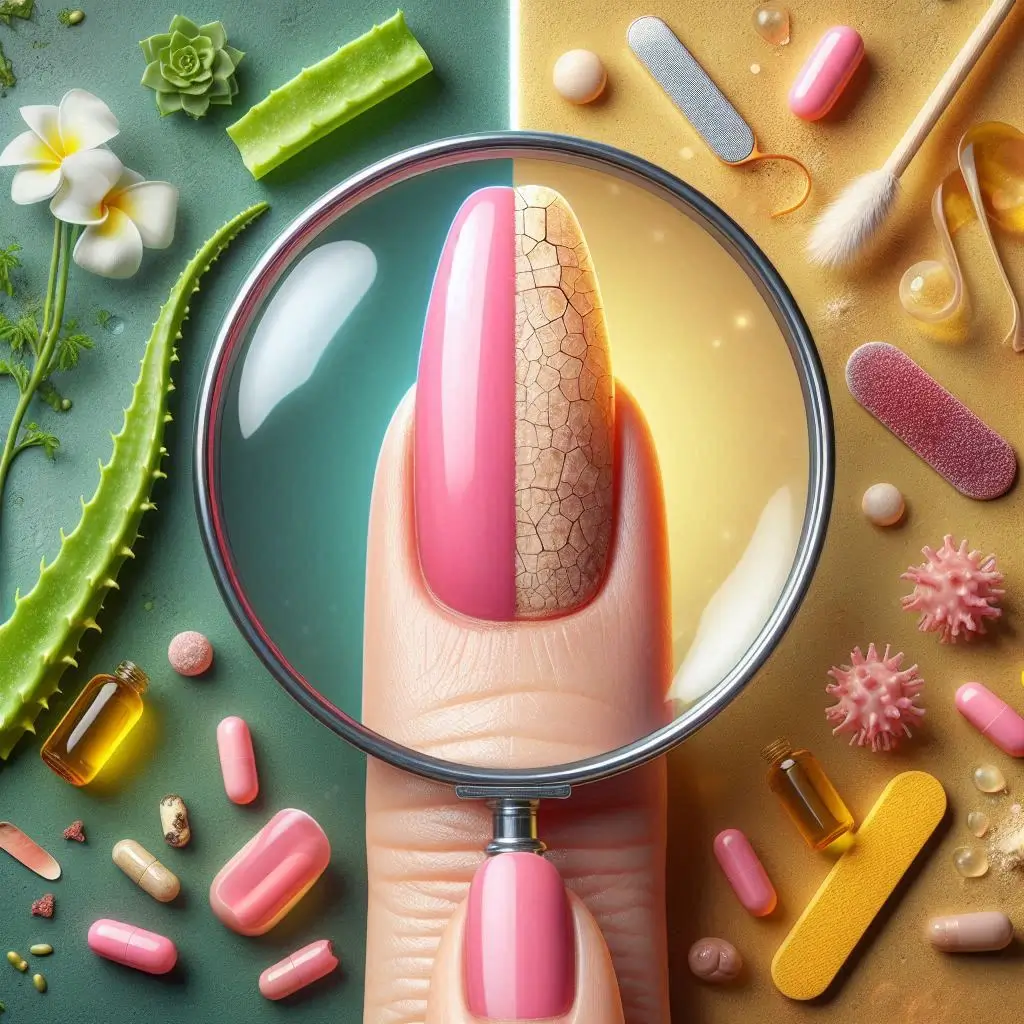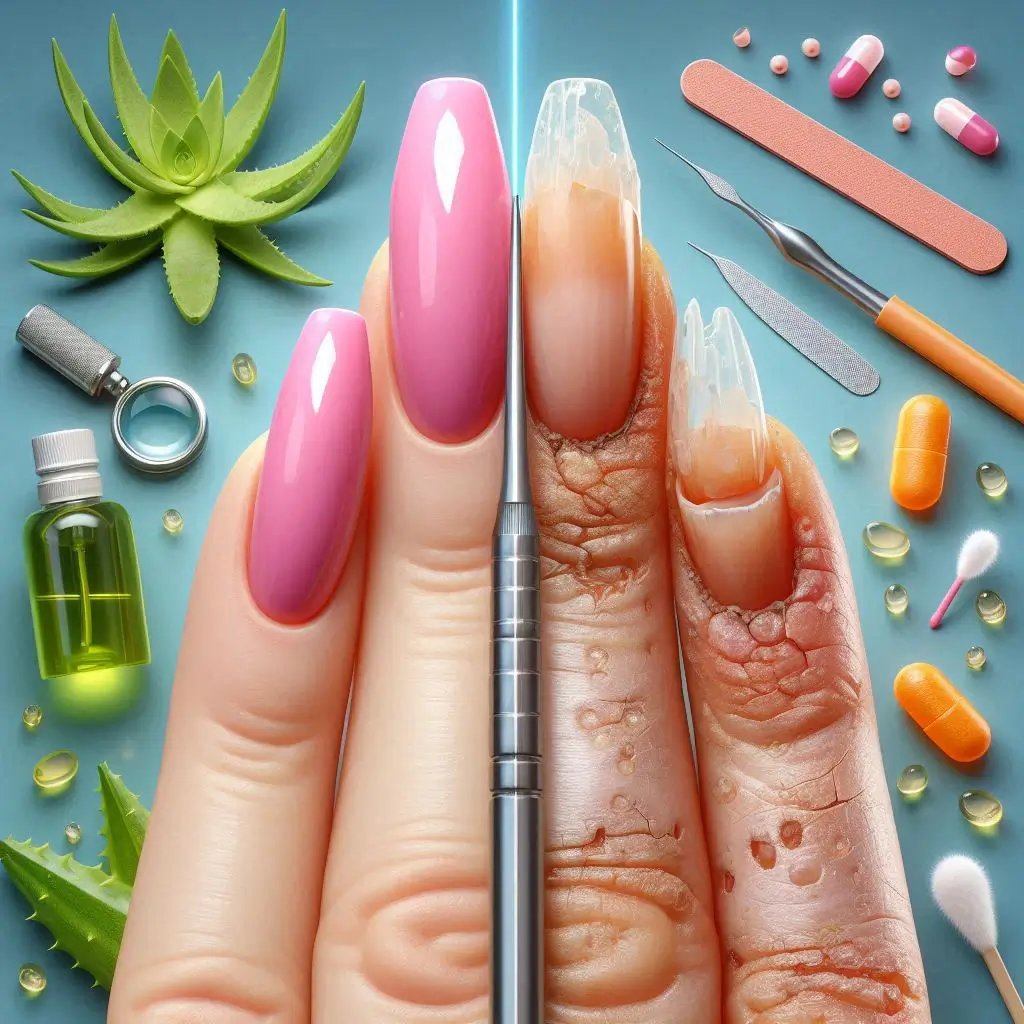Nail Health
Your nails are more than just a canvas for polish—they’re a mirror reflecting your overall health. From fungal infections to brittle edges, nail problems can signal underlying issues or lifestyle habits needing adjustment. tackling everything from fungal nails to acrylic removal. Whether you’re battling split nails or curious about Gel X longevity, we’ve got you covered. Let’s dive into the science, solutions, and secrets to maintaining nails that are as strong as they are beautiful.
What Causes Fungal Nails? (Onychomycosis)
Fungal nail infections, clinically termed onychomycosis, are caused by dermatophytes—microscopic fungi thriving in warm, damp environments. Common culprits include sweaty shoes, communal showers, or even minor nail injuries that create entry points. Symptoms like yellowing, thickening, and crumbly texture often worsen without treatment.

Science-Backed Fixes:
Topical antifungals like terbinafine or ciclopirox penetrate the nail bed to halt growth. For stubborn cases, oral medications (e.g., itraconazole) or laser therapy offer systemic solutions. Prevent recurrence by disinfecting shoes, avoiding synthetic socks, and drying feet thoroughly after showers.
Pro Tip:
Mix tea tree oil with coconut oil for a natural antifungal soak. Studies show tea tree oil’s terpenoids combat fungi without harsh side effects.
Understanding Ingrown Nails (Onychocryptosis)
Ingrown nails occur when the nail edge pierces the surrounding skin, triggering pain, redness, and sometimes infection. Causes range from tight footwear and rounded nail trimming to genetic predispositions like curved nail beds.
Step-by-Step Relief:
- Soak the affected area in warm water + Epsom salt for 15 minutes daily.
- Gently lift the nail edge with sterile cotton to encourage proper growth.
- For severe cases, a podiatrist may perform partial nail avulsion under local anesthesia.
Prevention:
Cut nails straight across and file edges slightly rounded. Opt for shoes with a wide toe box to reduce pressure.
Gel X Nails: Beauty vs. Risks
Gel X nails—a blend of gel polish and acrylic extensions—promise salon-quality durability. However, improper application or DIY removal can lead to nail thinning, allergic reactions(e.g., to methacrylates), or even permanent damage.
Safer Practices:
- Always have Gel X applied by a licensed technician using HEMA-free products.
- Remove them professionally every 3 weeks to avoid over-filing.
- Post-removal, apply a keratin-strengthening serum to rebuild nail layers.
Did You Know?
Gel X’s flexibility reduces cracking risk compared to traditional acrylics, but hydration is key. Use cuticle oil twice daily!
Why Do Fingernails Split? (Onychoschizia)
Split nails often stem from moisture imbalance. Frequent hand washing, exposure to cleaning chemicals, or low humidity dehydrate nails, making them prone to peeling. Nutritional gaps—particularly in biotin, iron, or zinc—also play a role.
Repair Routine:
- Apply a nail hardener with hydrolyzed keratin.
- Wear gloves while washing dishes or gardening.
- Boost intake of eggs, spinach, and nutsfor biotin and omega-3s.
Myth Buster:
“Nail polish weakens nails.” Not true! Non-acetone removers and breathable polishes (e.g., “5-free” formulas) can protect nails from environmental damage.
Brittle Nails: More Than Just Dryness
Brittle nails aren’t just a cosmetic nuisance—they can signal thyroid disorders, anemia, or aging-related collagen loss. External factors like acetone overuse or excessive UV exposure worsen fragility.
Hydration Hacks:
- Slather on jojoba oil (mimics natural sebum) before bed.
- Swap acetone removers for soy-based alternatives.
- Try a paraffin wax treatment to lock in moisture.
Expert Insight:
“Brittle nails that don’t improve with hydration may require blood tests to check thyroid or iron levels.” — Dr. Emily Chen, Board-Certified Dermatologist
DIY Acrylic Nail Removal: Step-by-Step Safety
Ripping off acrylics might satisfy a craving for instant gratification, but it’s a recipe for disaster. Here’s how to remove them safely:
What You’ll Need:
- 100% acetone
- Aluminum foil or clips
- Cuticle pusher
- Nail buffer
Process:
- File the acrylic top layer to break the seal.
- Soak cotton balls in acetone, place on nails, and wrap with foil for 15–20 mins.
- Gently scrape off softened acrylic—never force it.
- Buff gently and apply a nail strengthener.
Warning:
If nails feel sore or thin, pause and consult a professional. Over-soaking can dehydrate nails.
Nail Care Comparative Guide
| Issue | Primary Cause | Best Treatment | Prevention Tip |
|---|---|---|---|
| Fungal Nails | Damp environments | Oral terbinafine | Disinfect shoes weekly |
| Ingrown Nails | Tight shoes | Warm water soaks | Trim nails straight |
| Split Nails | Nutrient deficiency | Biotin supplements | Wear gloves during chores |
| Brittle Nails | Aging/chemical exposure | Jojoba oil + soy remover | Limit hand sanitizer use |
| Acrylic Damage | Over-filing | Professional removal | Hydrate with vitamin E oil |
FAQ
Can I wear Gel X nails if I have weak nails?
Yes, but opt for short extensions and prioritize hydration between sets.
Are fungal nails contagious?
Highly! Avoid sharing nail clippers or towels.
How often should I trim my nails?
Every 2 weeks, cutting straight across to prevent ingrowth.
Do nail hardeners work?
Temporarily, but overuse can cause brittleness—rotate with moisturizers.
Can stress affect nail health?
Absolutely. Stress depletes B vitamins, leading to ridges or breakage.
Is “greenies” (Pseudomonas) from gel polish dangerous?
It’s a bacterial infection—treat with antibiotics and avoid water exposure.
Why do my nails have white spots?
Usually harmless, caused by minor trauma. Persistent spots may indicate zinc deficiency.
Can nails regrow after severe damage?
Yes, but it takes 3–6 months. Protect the nail bed during regrowth.
Are press-on nails safer than acrylics?
Yes, as they require no drilling, but limit wear to 1 week to avoid glue damage.
Do collagen supplements improve nails?
Studies show they can boost thickness by 12% in 6 months.
Nail health isn’t about perfection—it’s about proactive care. From tackling fungal invaderswith clinical precision to mastering acrylic removal without tears, this guide arms you with dermatologist-approved strategies. Remember, every split or splinter holds a clue; listen to your nails, nourish them relentlessly, and never underestimate the power of a good cuticle oil. Ready to flaunt healthier nails? Start today—your future self will thank you
